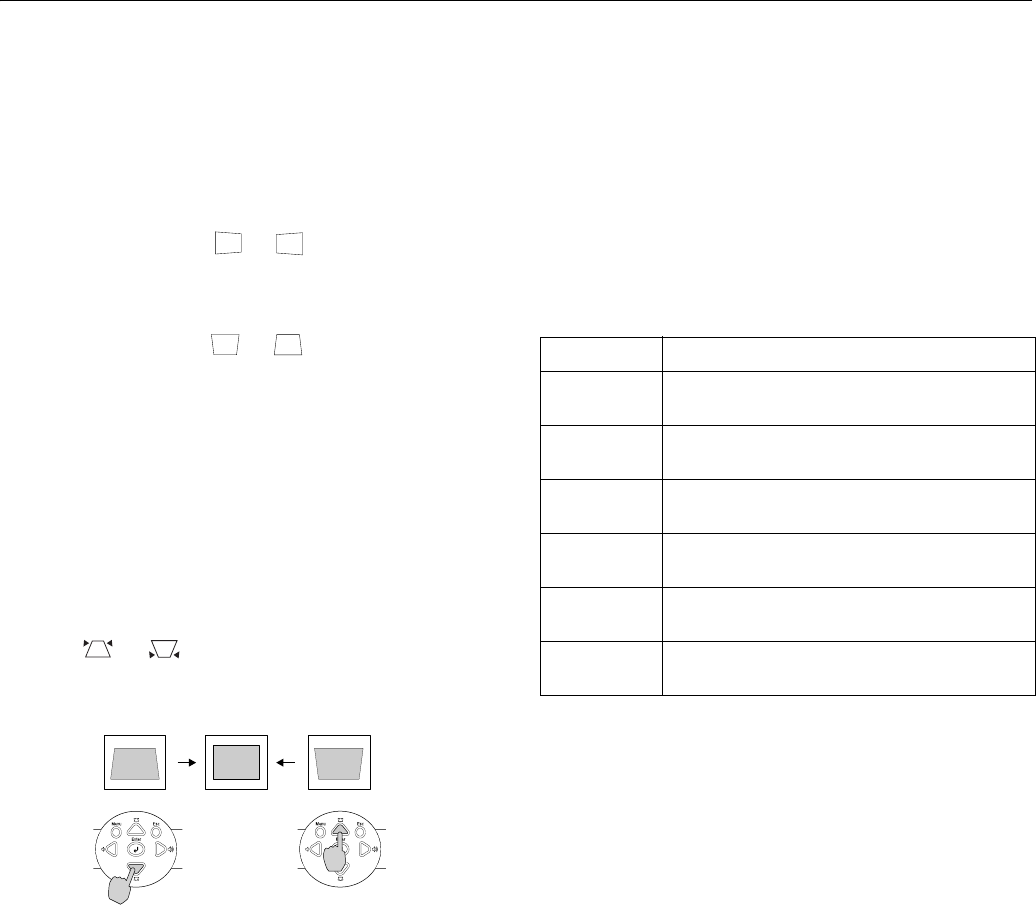
Epson PowerLite 821p Projector
6 - Epson PowerLite 821p Projector 9/04
Adjusting the Image Shape
The projector automatically corrects images that are distorted
when the projector is tilted up or down (up to a 15° tilt). The
Keystone window appears on the screen while the projector
makes the correction. If the projected image still isn’t
rectangular or has a “keystone” shape, do one or more of the
following:
❏ If your image looks like or , you’ve placed the
projector off to one side of the screen, at an angle. Move it
directly in front of the center of the screen, facing the screen
squarely.
❏ If your image looks like or , the Auto Keystone
feature may have been disabled or you may need to manually
adjust the keystone correction value. (Auto Keystone is not
available when you’re using ceiling or rear projection.)
Follow the instructions below:
❏ To turn on Auto Keystone, press the
Menu button on
the projector or remote control. Select the
Setting menu,
then press
Enter. If Auto Keystone is OFF, highlight this
option and press
Enter. Select ON in the Auto Keystone
window that appears and press
Enter to save your
changes. Exit the menu by pressing the
Menu button.
❏ To manually adjust the keystone correction value, press
the or button on the projector to correct the
shape of the image. After correction, your image will be
slightly smaller.
You can also make keystone adjustments using the projector’s
Setting menu.
Adjusting the Brightness
The brightness of an image depends on the source you are
projecting and the amount of light in the room. If the image is
too bright or not bright enough, do one of the following:
❏ Change the
Brightness setting in the Image menu.
❏ Select
Low or High for the Brightness Control option in
the Setting menu. Low brightness mode extends the life of
the lamp and decreases the fan noise.
Adjusting the Color Mode
You may want to adjust the color mode to select a setting
that is appropriate for the image you’re projecting and the
environment in which you’re projecting it.
If you’re projecting computer or RGB video images, the default
color mode is
Presentation, which is appropriate for
presentations in bright rooms. For other images, the default
color mode is
Dynamic, which optimizes video images using
natural colors.
The following table lists the available color modes.
To change the color mode, press the
Color Mode button on
the remote control until you see the mode you want. The
currently selected setting appears in the upper right corner of
the screen. You can also use the projector menu system to select
the Color Mode in the Image menu.
Correcting Computer Images
If you’ve connected a computer and the image doesn’t look
right, or it doesn’t fit properly on the screen, press the
Auto
button on the remote control or the
Enter button on the
projector. This automatically resets the projector’s tracking,
sync, resolution, and position settings. (You must be projecting
an image for this button to have any effect.) The screen turns
black for a few seconds, and then the image appears again. After
the image reappears, it takes about three seconds for the
correction to take effect. Don’t press any other buttons while
this is happening.
Note:
If the
Auto Setup option in the Signal menu is set to OFF, the
Auto function will not work.
Color mode Description
sRGB
For matching the color palette of standard sRGB
computer displays.
Dynamic
For increased brightness in bright rooms (the
default for non-computer display).
Presentation
For computer presentations (the default when
projecting from a computer with analog video).
Theater
For optimizing movie images with increased
contrast.
Living Room
For increased brightness when playing video
games or watching TV in a bright room.
Blackboard
For projecting accurate colors on a green
chalkboard (adjusts the white point).
